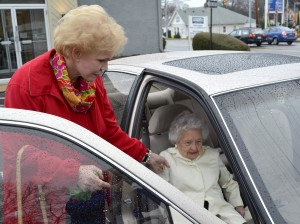Neighbors Helping Neighbors
By Kelly Medinger
05-03-2018
Partners In Care uses human services grant to harness the talents of its members to support the independence of older adults
 “It’s my heart and soul, and the most phenomenal place I’ve ever worked,” declares Mandy Arnold, President & CEO of Partners In Care in Anne Arundel County. Reflecting on her 23-year career in healthcare, she is thankful to be in a place where community members come together to help one another, with a special focus on the senior population.
“It’s my heart and soul, and the most phenomenal place I’ve ever worked,” declares Mandy Arnold, President & CEO of Partners In Care in Anne Arundel County. Reflecting on her 23-year career in healthcare, she is thankful to be in a place where community members come together to help one another, with a special focus on the senior population.
About Partners In Care
For 25 years, Partners in Care (PIC) has helped older adults remain independent and an active part of their community, through the exchange of the time and talents of its membership. Its membership has grown dramatically since its founding, from 13 volunteers helping roughly a dozen seniors, to more than 900 volunteers helping upwards of 1,000 older adults.
PIC’s services mostly consist of transportation and home repairs, both of which support seniors aging in place. Members do not pay money for these services, but rather give their time and talent in exchange for them. The membership process includes an application, orientation, and background check. Whether a member is a provider or receiver of services, everyone is considered a member, and no one is turned away.
The Knott Foundation has awarded PIC five grants over the past 15 years, most recently for general operating support. “We could not do what we do without this type of support,” shares Mandy.
Stories From the Field
One PIC member drove a patient to her chemotherapy appointments for an entire first round of treatment. When the patient needed a second round of treatment, the member rearranged her schedule so that she could be the one to continue driving her. The patient’s cancer is now in remission.
Another member had been driving a 94-year-old woman to the grocery store for some time, when a new PIC volunteer took the shift. The member called to check-up on the new volunteer and make sure he was “doing everything right,” Mandy laughs. “She wanted to make sure the new volunteer was going into the store with the woman, getting everything on her list, stopping to buy her and her husband a sub on the way home, and putting all the groceries away in the cupboard once they were home.”
A Talent Bank
When asked how PIC has managed to grow over the years and still maintain such a personal touch, Mandy states, “Everyone is treated with dignity and respect. Their value is based on the time they can commit, not monetary net worth. Members feel it is a give and take, and not a charity.”
Leveraging the time and talent of members is a serious part of PIC’s service model. Some members provide home repairs. Other members write birthday cards to the general membership. Recently, 25 members baked deserts for a local fundraising event.
“Everyone has their own talent and all of these talents together is what we were created to be – an organization of neighbors helping neighbors,” Mandy concludes.
